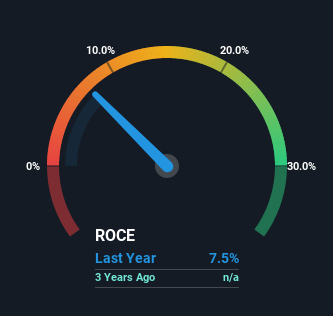- India
- /
- Construction
- /
- NSEI:GMRP&UI
GMR Power And Urban Infra (NSE:GMRP&UI) Has Some Way To Go To Become A Multi-Bagger
If we want to find a potential multi-bagger, often there are underlying trends that can provide clues. Typically, we'll want to notice a trend of growing return on capital employed (ROCE) and alongside that, an expanding base of capital employed. Ultimately, this demonstrates that it's a business that is reinvesting profits at increasing rates of return. Having said that, from a first glance at GMR Power And Urban Infra (NSE:GMRP&UI) we aren't jumping out of our chairs at how returns are trending, but let's have a deeper look.
Return On Capital Employed (ROCE): What Is It?
For those who don't know, ROCE is a measure of a company's yearly pre-tax profit (its return), relative to the capital employed in the business. The formula for this calculation on GMR Power And Urban Infra is:
Return on Capital Employed = Earnings Before Interest and Tax (EBIT) ÷ (Total Assets - Current Liabilities)
0.075 = ₹3.1b ÷ (₹121b - ₹79b) (Based on the trailing twelve months to December 2022).
Thus, GMR Power And Urban Infra has an ROCE of 7.5%. In absolute terms, that's a low return and it also under-performs the Construction industry average of 12%.
See our latest analysis for GMR Power And Urban Infra

Historical performance is a great place to start when researching a stock so above you can see the gauge for GMR Power And Urban Infra's ROCE against it's prior returns. If you're interested in investigating GMR Power And Urban Infra's past further, check out this free graph of past earnings, revenue and cash flow.
So How Is GMR Power And Urban Infra's ROCE Trending?
We're a bit concerned with the trends, because the business is applying 33% less capital than it was one year ago and returns on that capital have stayed flat. To us that doesn't look like a multi-bagger because the company appears to be selling assets and it's returns aren't increasing. Not only that, but the low returns on this capital mentioned earlier would leave most investors unimpressed.
Another thing to note, GMR Power And Urban Infra has a high ratio of current liabilities to total assets of 66%. This effectively means that suppliers (or short-term creditors) are funding a large portion of the business, so just be aware that this can introduce some elements of risk. While it's not necessarily a bad thing, it can be beneficial if this ratio is lower.
The Bottom Line On GMR Power And Urban Infra's ROCE
Overall, we're not ecstatic to see GMR Power And Urban Infra reducing the amount of capital it employs in the business. And investors appear hesitant that the trends will pick up because the stock has fallen 61% in the last year. Therefore based on the analysis done in this article, we don't think GMR Power And Urban Infra has the makings of a multi-bagger.
If you want to know some of the risks facing GMR Power And Urban Infra we've found 4 warning signs (2 are a bit unpleasant!) that you should be aware of before investing here.
While GMR Power And Urban Infra may not currently earn the highest returns, we've compiled a list of companies that currently earn more than 25% return on equity. Check out this free list here.
Mobile Infrastructure for Defense and Disaster
The next wave in robotics isn't humanoid. Its fully autonomous towers delivering 5G, ISR, and radar in under 30 minutes, anywhere.
Get the investor briefing before the next round of contracts
Sponsored On Behalf of CiTechNew: Manage All Your Stock Portfolios in One Place
We've created the ultimate portfolio companion for stock investors, and it's free.
• Connect an unlimited number of Portfolios and see your total in one currency
• Be alerted to new Warning Signs or Risks via email or mobile
• Track the Fair Value of your stocks
Have feedback on this article? Concerned about the content? Get in touch with us directly. Alternatively, email editorial-team (at) simplywallst.com.
This article by Simply Wall St is general in nature. We provide commentary based on historical data and analyst forecasts only using an unbiased methodology and our articles are not intended to be financial advice. It does not constitute a recommendation to buy or sell any stock, and does not take account of your objectives, or your financial situation. We aim to bring you long-term focused analysis driven by fundamental data. Note that our analysis may not factor in the latest price-sensitive company announcements or qualitative material. Simply Wall St has no position in any stocks mentioned.
About NSEI:GMRP&UI
GMR Power And Urban Infra
Engages in the energy, urban infrastructure, and transportation businesses in India.
Good value with slight risk.
Similar Companies
Market Insights
Weekly Picks

THE KINGDOM OF BROWN GOODS: WHY MGPI IS BEING CRUSHED BY INVENTORY & PRIMED FOR RESURRECTION


Why Vertical Aerospace (NYSE: EVTL) is Worth Possibly Over 13x its Current Price


The Quiet Giant That Became AI’s Power Grid
Recently Updated Narratives

Jackson Financial Stock: When Insurance Math Meets a Shifting Claims Landscape

Stride Stock: Online Education Finds Its Second Act

CS Disco Stock: Legal AI Is Moving From Efficiency Tool to Competitive Necessity
Popular Narratives


MicroVision will explode future revenue by 380.37% with a vision towards success


Crazy Undervalued 42 Baggers Silver Play (Active & Running Mine)





